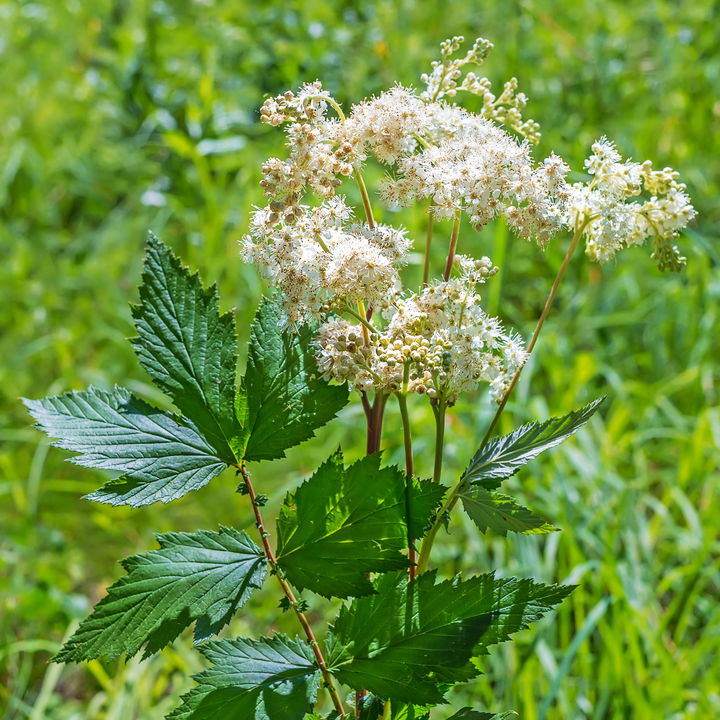Profile
Even in Celtic times, meadowsweet was considered one of the most important medicinal plants by the Druids. The flowers and the herb are still used today as medicinal drugs, and parts of the plant are also used in cooking.
There are two theories as to the origin of the German name "Mädesüß". The first theory is that it is derived from the old German word "Met", which used to be flavoured with the flowers. According to the second theory, the name could come from the old German "Mahd = to mow", as the meadowsweet gave the hay a sweet flavour.
Utilisation

Both the flowers and the herb of meadowsweet, Filipendula ulmaria (L.) Maxim, are used as medicinal drugs for the supportive treatment of colds.
According to the German Medicines Codex, meadowsweet flowers(Spiraeae flos) must have a minimum content of 1.8 % flavonoids in relation to the dried drug. Meadowsweet herb(Filipendulae ulmariae herba), according to Pharmacopoea Europaea, contains the dried flowering stem tips and must contain at least 1 ml/kg of essential oil.
The main constituents of the plant include flavonoids (e.g. spiraeoside), phenol glycosides (glycosides of salicylaldehyde), essential oil (with the main components salicylaldehyde and salicylic acid methyl ester) and up to 20 % tannins. Salicylic acid methyl ester, a "relative" of aspirin, is hardly present in the intact plant and is only produced by splitting the salicyl glycosides, e.g. when rubbed, hence the odour reminiscent of methyl salicylate after rubbing or moistening with water.
Pharmacological studies have shown analgesic and anti-inflammatory effects. However, no clinically proven efficacy can be derived from these studies. In addition, the content of salicylic acid compounds, which could have a similar effect to acetylsalicylic acid, is low. Nevertheless, caution should be exercised when using it if you are allergic to salicylates.
Both medicinal drugs are also said to have diaphoretic and diuretic properties, which is why they are used as part of "sweating cures" to support the onset of colds.
The plant is also used in the kitchen. Young shoots and roots are used as wild vegetables and the flowers are used to flavour jellies and drinks.
Scented bouquets are a popular scenting herb for improving the air in rooms.
Botany
The meadowsweet(Filipendula ulmaria) belongs to the rose family(Rosaceae).
In the terminal flower panicle, several flowers with a five-petalled, creamy white corolla and numerous stamens are united to form a large, bright flower. The stem of the meadowsweet grows upright to a height of 150 cm and has alternate leaves.
The lower leaves have long stalks and are intermittently pinnate with two to five pairs of large, pointed-ovate lateral leaflets and three-lobed terminal leaflets. The upper leaves, on the other hand, sit almost on the stem and consist only of the three-lobed terminal leaflet. The leaf surface is matt green on the upper side and usually glabrous, but with dense grey to white felt-like hairs on the veins or over the entire surface on the underside. The leaf margin is shallowly double serrated.
Distribution
In Austria and Europe there are only two species of Filipendula, the greater meadowsweet and the lesser meadowsweet. The genus comprises around 15 species worldwide. The medicinally used species(Filipendula ulmaria) can be found from Great Britain through Central and Northern Europe to Eastern Siberia and Mongolia. It grows in damp to wet meadows (cabbage thistle meadows), litter meadows, riparian scrub, siltation communities, fens and alder swamp forests in the colline (plains and hills) to subalpine altitudes.
The spreading, creamy flower panicle with its honey, vanilla or almond-like odour attracts numerous insects, including bees, pollen-eating flies, hoverflies and beetles for pollination.
The leathery, hard nutty fruits are spread by wind, water and animals.
Service
The preservation of diversity is very important to us, which is why we store around 5,400 samples of seeds and plants in our gene bank . With the gene bank for agricultural crops, medicinal and aromatic plants, we are making a significant contribution to the preservation of biodiversity.
Last updated: 12.09.2024
automatically translated